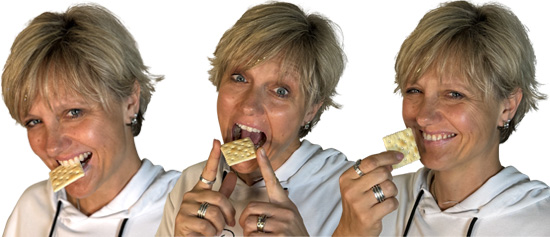The Cracker Test:
A Simple Guide to Understanding Your Carb Tolerance
Ever wonder why some people can eat pasta and bread without gaining a pound while others feel bloated just looking at carbs? It might come down to a simple test you can do at home with a plain saltine cracker.
The cracker test, or amylase test, is a quick way to see how your body handles carbs. Just chew a plain, unsalted cracker and note how long it takes to taste sweet. The sweetness is from the enzyme amylase in your saliva which breaks down the starches into sugars.
How to Perform the Cracker Test
Grab a plain, unsalted saltine cracker or, if you’re following a gluten-free diet, a dime-size piece of raw peeled potato. Do not add salt, as you want to detect the change in flavor clearly.
Get a timer ready. The moment you start chewing, start the timer.
Place the cracker in your mouth and chew slowly without swallowing. Just keep chewing.
You’re going to time the sweetness. Pay close attention to the flavor and note how long the cracker takes to taste sweet. For best results, repeat the test three times and average the results.
What Do the Results Mean?
FULL is (10-14 seconds): If the cracker tastes sweet quickly, within 10 to 20 seconds, you likely have high salivary amylase levels. Your body is good at breaking down carbs, so you might tolerate more carbs without adverse effects. People in this category can generally have up to 50% of their daily calories from carbohydrates, 20% from protein, and 30% from fats.
MODERATE is (15-30 seconds): If it takes a bit longer, you’re in the middle range. You can enjoy carbs but might want to monitor your intake. For you, a balanced diet might include up to 35% of daily calories from carbs, 30% from protein, and 35% from fats.
RESTRICTED is (30+ seconds): If it takes over 30 seconds or if you don’t notice any change, your body might not process carbs as efficiently. You might want to limit your carb intake to no more than 25% of your daily calories, with 35% from protein and 40% from fats.
The cracker test provides insight into how your body starts to digest carbohydrates. According to Dr. Sharon Moalem, who discussed this test in his book The DNA Restart: Unlock Your Personal Genetic Code to Eat for Your Genes, Lose Weight, and Reverse Aging (2016), the speed at which the cracker changes flavor can indicate how many copies of the amylase gene you have. More copies generally mean better carb digestion.
This test gained popularity after being featured on the BBC show The Truth About Carbs. It offers a simple way to tailor your diet to your genetic makeup without fancy equipment or expensive tests.
Studies have found that people with more copies of the AMY1 gene, which produces salivary amylase, have higher levels of the enzyme. This allows them to break down starches more efficiently. Think of it as having a high-powered kitchen appliance that makes cooking (or digesting carbs) much easier.
This difference in amylase levels can help explain why some people can thrive on a high-carb diet while others do better with fewer carbs.
While the saltine cracker test is an interesting way to get an idea of your body’s initial carb digestion capability, it has its limitations:
It’s not a comprehensive measure: The test only provides a rough estimate of how your body begins to process carbs in the mouth. It doesn’t account for the more complex digestion processes that happen further along the digestive tract.
Significant individual variability can occur. Carb needs vary greatly among individuals due to factors like age, activity level, metabolic health, and specific dietary goals. The test shouldn’t be the sole determinant of your carb intake.
It’s best to talk to a healthcare professional or a registered dietitian for personalized advice. They can help you figure out what works best for your body based on a thorough assessment.
Aim for a balanced diet with whole grains, fruits, and vegetables regardless of your carb tolerance. These foods provide fiber, vitamins, and minerals essential for good health.
Pay attention to how different foods make you feel. If carbs make you feel sluggish or bloated, you might benefit from reducing your intake, regardless of the cracker test results.
The cracker test is a fun, informal way to glimpse your body’s carb digestion. While it’s not a substitute for professional advice, it can help you understand your body more. So next time you’re pondering that extra slice of bread, remember—you’ve got a cracker test to guide you.
Reference Links:
Copy number variation of human AMY1 is a minor contributor to variation in salivary amylase expression and activity
Danielle Carpenter, Laura M. Mitchell & John A. L. Armour
Human Genomics, Published 20 February 2017
Individual Differences in AMY1 Gene Copy Number, Salivary α-Amylase Levels, and the Perception of Oral Starch
Abigail L. Mandel,Catherine Peyrot des Gachons,Kimberly L. Plank,Suzanne Alarcon,Paul A. S. Breslin
PLOS ONE, Published October 13, 2010 https://doi.org/10.1371/journal.pone.0013352
Diet and the evolution of human amylase gene copy number variation
George H Perry, Nathaniel J Dominy, Katrina G Claw, Arthur S Lee, Heike Fiegler, Richard Redon, John Werner, Fernando A Villanea, Joanna L Mountain, Rajeev Misra, Nigel P Carter, Charles Lee & Anne C Stone
Nature Genetics, Published 09 September 2007
Call for a FREE Consultation (305) 296-3434
CAUTION: Check with your doctor before
beginning any diet or exercise program.
6/15/2024



